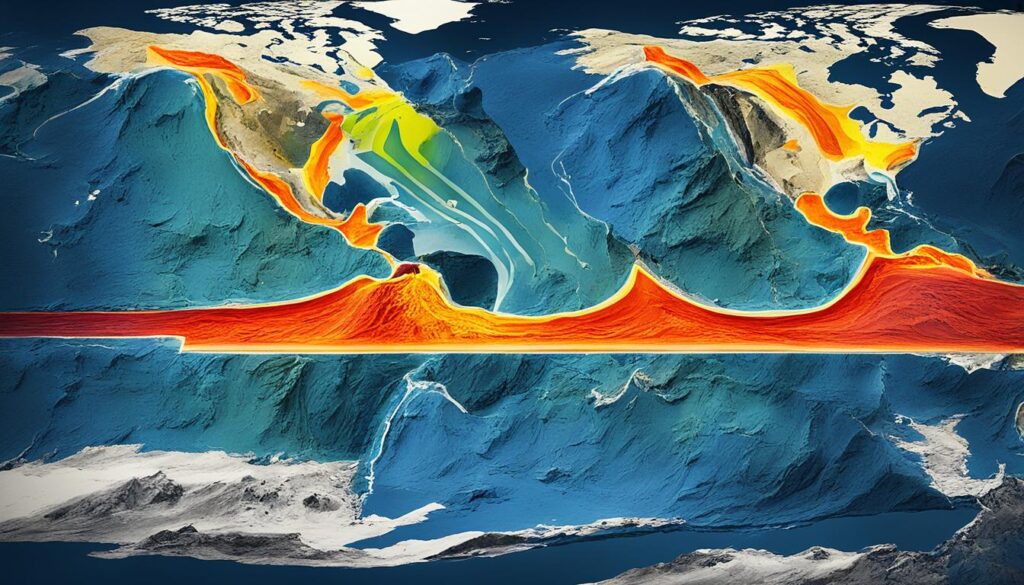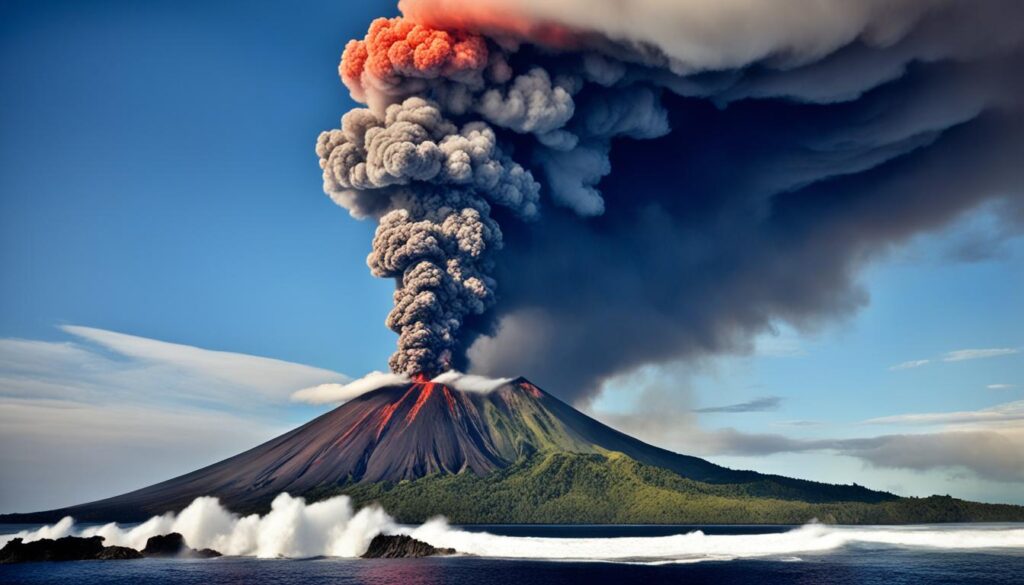Volcanoes have always fascinated us with their powerful eruptions and the display of nature’s power. But what’s the science behind these natural wonders? This article will explore the world of volcanoes. We’ll look at their main parts, types, and how they form. We’ll also discuss the signs of volcanic eruptions, their effects, and how scientists study them.
The science of volcanoes is complex and interesting. It involves the movement of the Earth’s plates and the beautiful lava flows. Let’s dive into the mysteries of these powerful forces and learn more about our dynamic planet.
What is a Volcano?
A volcano is a break in the Earth’s crust that lets out hot lava, ash, and gases from below. It’s not just a natural wonder; it’s a key part of our planet’s shape. Volcanoes help shape the Earth in many ways.
Definition and Key Components
A volcano is a mountain made from stuff that comes out through the Earth’s surface. It has a magma chamber under the ground, where hot rock and gases are stored. The vent or crater is where the volcano’s material comes out. The edifice is the volcano’s main structure.
Types of Volcanoes
Volcanoes vary in size and shape. They can be classified by their structure and how they erupt. Common types include shield volcanoes, composite volcanoes, and cinder cone volcanoes. Each type is unique and interesting to study.
The Anatomy of a Volcano
Volcanoes are complex structures with many layers and parts. They work together to create the dramatic eruptions we see. To understand volcanoes, we must look at their detailed anatomy. From the deep magma chambers to the visible crater, each part is key to the volcanic process.
At the center of a volcano is the magma chamber. It’s a big reservoir of molten rock, gases, and minerals deep in the Earth. When pressure in the magma chamber grows, the molten material moves up a vertical conduit or pipe. It then erupts at the surface through the volcano’s crater. The crater is a bowl-shaped hole at the top. It’s the main way lava, ash, and gases come out during an eruption.
Around the magma chamber and conduit are the volcano layers. These include the outer volcano interior, made of solidified lava flows, ash, and other materials. These layers support the volcano and affect the type and strength of eruptions.
Knowing about the volcano anatomy and volcano structure helps us predict and prepare for volcanic activity. By studying the volcano’s inside, scientists can forecast eruptions, understand hazards, and protect communities.
The Educational Formation of Volcanoes
Learning about how volcanoes form is key in volcano education. At the core, plate tectonics is crucial. It helps us understand how our Earth changes. By studying plate tectonics, we learn about the movement and interaction of Earth’s plates. This knowledge is key to understanding volcanoes and their activity.
Plate Tectonics and Volcanic Activity
Volcanoes often come from where tectonic plates meet or pull apart. This can lead to magma, or molten rock, coming out from the Earth. When plates collide or move apart, they create hot and pressurized areas. These areas can form volcanoes, especially near the Pacific “Ring of Fire.”
Studying plate tectonics helps us see how our planet changes. It shows us the forces that create the stunning volcanic landscapes we see. This knowledge is important for anyone interested in volcanoes and Earth’s history.

Learning about volcanoes through plate tectonics is enlightening. It helps students and enthusiasts see how our world changes. This knowledge improves our understanding of volcanoes and the Earth’s ongoing changes.
Volcanic Eruptions Explained
Volcanic eruptions are fascinating and powerful events. They happen when magma, gases, and pressure work together. This mix leads to a big release of energy. By learning about this science, we can understand what causes eruptions and the signs they give before they happen.
Eruption Triggers and Warning Signs
Eruptions start with new magma going into the volcano, pressure from gases, and rock weakening. These things make a balance that can break suddenly. When it does, it leads to a big explosion.
Thanks to science, we can spot signs of an eruption coming. These signs include more earthquakes, changes in the volcano’s shape, and more gas coming out. Watching these signs helps scientists predict eruptions. This means we can warn people and get ready for safety.
Knowing about eruptions, their causes, and warning signs is key to staying safe. By being alert and informed, we can protect our communities from volcanic dangers.
The Power of Volcanic Eruptions
Volcanic eruptions show the amazing power of nature, changing landscapes and affecting people’s lives. They reveal the strength of Earth’s inner workings. They show how volcanoes can both destroy and build.
Destructive Forces
When volcanoes erupt, they release molten rock, ash, and hot gas. This can be very destructive. Lava flows can destroy towns and cities, covering them in hot rock. Pyroclastic flows move fast, burning everything they touch.
The ash from eruptions can stop planes from flying, hurt crops, and change the weather worldwide.
Volcanoes can change the land, bury towns, and cause a lot of damage. The 1980 eruption of Mount St. Helens in the U.S. is a good example. It killed over 50 people and caused a lot of damage.
Constructive Forces
But volcanoes also help shape the Earth. They make new islands, grow land, and add minerals to the soil. This is seen in places like Hawaii, where volcanoes have made new islands over time.
Volcanoes can also help the environment. They add nutrients to the soil and water, helping plants grow and supporting many ecosystems. The ash and gases can cool the planet, helping to fight climate change.
Volcanic Hazards and Safety Measures
Volcanoes are both amazing and dangerous. It’s important to know about the hazards and how to stay safe. They can cause ash falls and lava flows that threaten lives and property.
One big hazard is ash fall. Eruptions can send ash high into the air, which is bad for planes, buildings, and people. To stay safe, we watch the ash clouds, plan evacuation paths, and give out masks.
Lava flows are another big worry. They can destroy whole towns and cause a lot of damage. To protect people, we have early warning systems and evacuation plans. We also make buildings strong to handle the heat and pressure.
Volcanoes can also create deadly pyroclastic density currents. These are fast, hot flows of gas and rock. To stay safe, we map out danger zones and teach people to evacuate quickly if needed.
Knowing about the dangers and taking steps to stay safe can really help. By getting ready for disasters and using new tech, we can save lives and lessen the harm volcanoes can do.
Monitoring Volcanoes: Technology and Techniques
Predicting and responding to volcanic eruptions is crucial. Thanks to new technology, scientists now have better tools to watch and study volcanoes. These tools help them detect and understand volcanic activity.
Seismic Activity and Gas Emissions
Seismic activity is a key sign of a possible eruption. Scientists use seismometers to catch tiny tremors around volcanoes. This lets them see how magma and other processes are moving inside the volcano.
They can learn a lot about the volcano’s state by looking at these tremors. This helps them predict if an eruption might happen.
Measuring gas emissions is also important for watching volcanoes. Tools like spectrometers and gas sensors track gases like sulfur dioxide and carbon dioxide. If these gases increase, it might mean the volcano is getting ready to erupt.
By looking at both seismic activity and gas emissions, scientists can understand a volcano’s behavior. This helps them warn people and move them to safety if needed. This technology and the knowledge of scientists are key to dealing with volcanoes.
The Role of Volcanoes in Earth’s History
Volcanoes have been key in shaping our planet’s history. They have changed Earth since its start. From the early days to now, volcanoes have greatly affected the planet’s look, air, and life.
Volcanoes helped form Earth’s land, oceans, and air. When Earth cooled, volcanoes brought out the first continents and changed the air. This was key in making Earth ready for life.
Big eruptions have changed the climate and affected humans. The 1815 eruption of Tambora caused a “Year Without a Summer.” Yellowstone’s huge eruption long ago changed the weather and could have led to mass extinctions. These events show how volcanoes have shaped Earth’s past and will continue to do so.
Learning about volcanoes helps us understand Earth’s story. They’ve shaped the continents, changed the air, and affected the climate. By studying volcanoes, we appreciate the forces that made Earth what it is today.
Famous Volcanic Eruptions Throughout Time
Volcanic eruptions have changed human history from ancient times to now. They have amazed us and deeply affected many people and communities. Let’s look at some of the most famous eruptions and their big effects.
Mount Vesuvius and the Destruction of Pompeii
The eruption of Mount Vesuvius in 79 AD is a well-known disaster. It buried Pompeii under ash and lava. This event took thousands of lives and showed us what life was like in ancient Rome.
The ruins of Pompeii let archaeologists study the eruption’s effect on the ancient civilization.
The Eruption of Krakatoa and the Global Impact
In 1883, Krakatoa’s eruption was huge, sending waves and shockwaves around the world. It was one of the biggest eruptions ever, causing tsunamis and changing the weather far away. Scientists still study its effects on the planet today.
The Eruption of Mount St. Helens and the Lessons Learned
Mount St. Helens erupted in 1980, showing its power and teaching us a lot. It was the deadliest volcanic event in U.S. history. It helped us understand volcanoes better and how to warn people of eruptions.

These eruptions have left a big mark on history. From ancient Pompeii to today’s communities, they’ve changed our world. They teach us about the power of nature and help us learn how to deal with it.
Volcanoes and Their Influence on the Environment
Volcanoes are more than just natural wonders; they shape the environment around them. Scientists study how volcanic activity affects the Earth’s climate, ecosystems, and ecological processes. This relationship is both fascinating and complex.
When volcanoes erupt, they send ash, gases, and materials into the air. This can change the planet’s climate. Some eruptions even affect global temperatures, change where it rains, and disrupt weather patterns. Scientists are learning how to predict and lessen these effects.
But volcanoes aren’t all bad news for the environment. The lava and ash from eruptions can make soil rich and support diverse ecosystems. Volcanic islands become homes for unique plants and animals. These places show how life can thrive in tough conditions.






